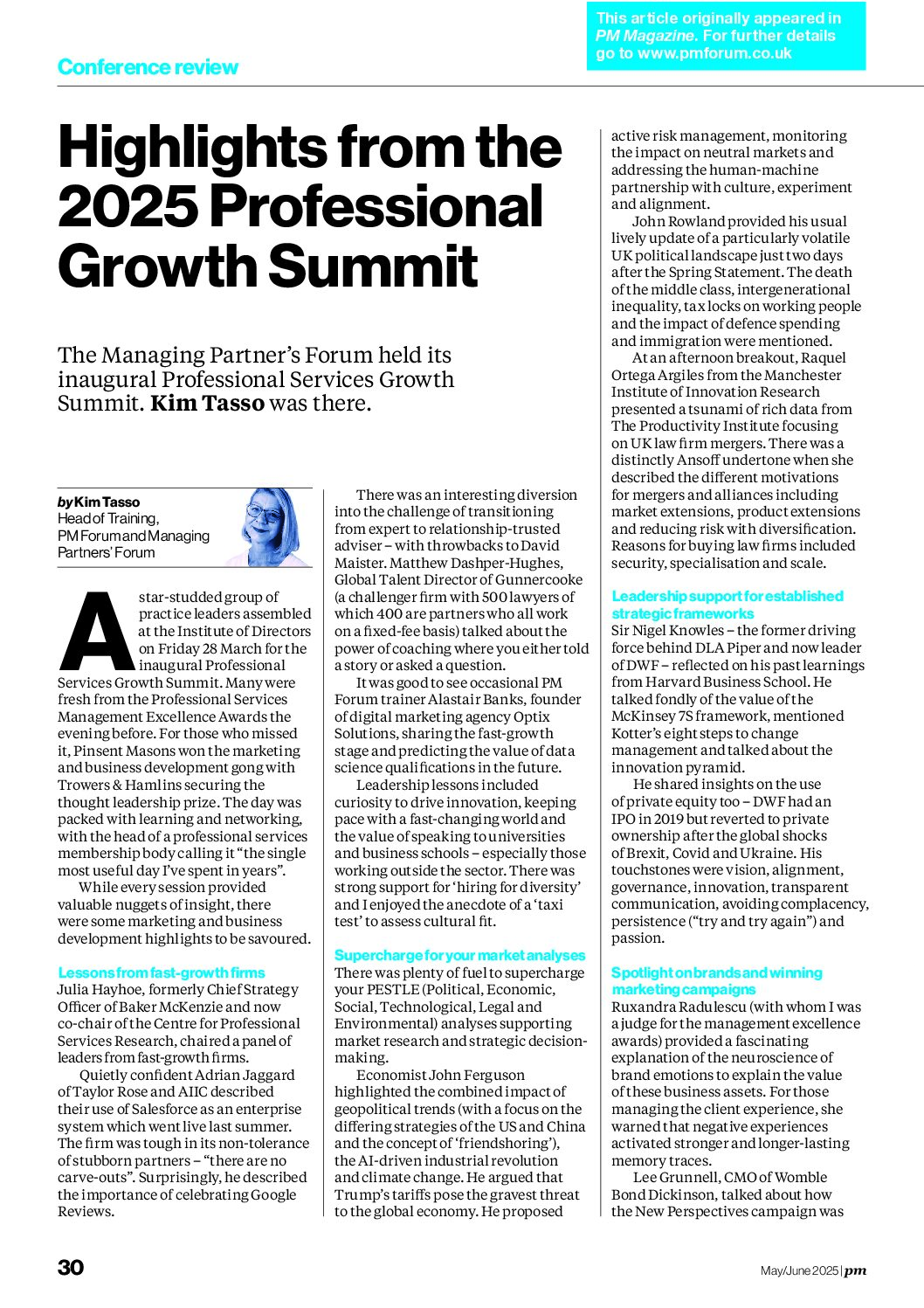There was an unfortunate article recently in one of the legal magazines that provided a rather damning view of the history of marketing in the profession. On the basis of interviews with a handful of people, it asserted that most marketers involved in legal marketing in the past were no good (I found this somewhat strange when some of those very marketers featured in the article had been around for a while).
As I was there at the very beginning I thought I’d offer my perspective on “Stone Age” legal marketing and speak up for some of the pioneers who have remained graciously and modestly quiet. I spent several years in marketing and sales roles in world leading technology companies before being one of the first marketers at a Big Four accounting firm and then headhunted to take the first senior marketing role in 1989 at what is now a top 30 law firm.
Since then, I have worked with over 200 law firms both overseas and in the UK – global firms, City firms, regional firms, medium sized firms and even sole practitioners – both at Board level and with marketing folk, many of whom I have also met in my role as lead trainer for the Professional Marketing Forum and as a lecturer for the Chartered Institute of Marketing (CIM). Some of those medium firms mentioned in the article as having outstanding marketing are amongst my client list. I’ve also spent a fair amount of time working with accountancy and property firms to add another dimension.
Exactly what is marketing?
But first, let’s be clear about what we mean by “marketing”:
1. In a business-to-business (B2B) environment, which is the focus of most large commercial law firms,marketing and selling are inextricably connected but they are NOT the same thing. Business development is a term that spans marketing, selling and relationship management. Professionally trained marketers – unless they come from consumer goods or the technology sector – are rarely formally trained in selling.
2. Professional rules and tradition positioned the lawyers alone at the forefront of the client relationship. This meant that a primary function of marketing – to be the client’s representative – was initially disabled. In recent years though, we have seen a huge growth in the good work done by marketers in establishing client listening, review and account management programmes. But there were some firms that embarked upon client research programmes much earlier.
3. The other major function of marketing – to increase profitability – was hampered in the legal profession by two factors. First, the profit margins at law firms were amongst the highest across all markets. Second, very few law firms were able to analyse profit by client, work type, service, lawyer or market. So it was almost impossible for marketers to develop strategies to increase profitability when this couldn’t be analysed or measured. So they were left with two options – the untrained marketers took the path of least resistance and tackled the somewhat superficial (without a strong underlying strategy) marketing communications activities of brochures, databases and events and the early pioneers who were professionally qualified and survived became excellent change managers – guiding those firms (who lacked management training) to develop their first business strategies before they could get round to their role of marketing and selling.
4. Strategic marketing is about making choices. An organisation and its markets are analysed and the best opportunities and strategies are selected. This means that resources are focused to leverage competitive advantage. Most legal partnerships were unable to say “no” to anything that a partner wanted and flat refused to make a choice about which markets and services to pursue. So activity was spread far too thinly and the resources available were totally inadequate.
5. As the article notes, historically there was more demand than supply for top quality lawyers so the need for strategic marketing (and selling) was not properly recognised. As a result of recession, deregulation and technology many legal services have moved from intangible advisory services to low value commodities. Thus the need for brands(which differentiate and confer a higher price) is but a recent phenomenon in the profession – and more so in the consumer legal services market.
6. Marketing is about cultural change – particularly in a service business. It is about instilling a market and client facing attitude throughout an organisation. It means looking first at the client needs and shaping an organisation’s resources to meet those needs profitably – not just selling more and more of what the organisation decides it wants to produce. It is fiendishly hard to achieve any cultural change in any organisation and marketing is no different. And with law firms being partnerships, the challenge is compounded.
Observations on the legal market
Turning to the legal market, a few further observations:
1. The legal market wasn’t ready for marketing Many early marketers in the professions – and there were some brilliant marketers from FMCG and financial services – simply were not prepared to waste their time and expertise battling with partnerships who were just not ready to take the plunge and try to operate as a business rather than a fiefdom/partnership. They left to pursue their careers in environments where their talents would be put to good use.
2. Big law marketing is very different to medium law marketing In a big law firm the nature of the markets, clients and services – and therefore the marketing task and the resources available – is very different to that of a medium or small law firm. Therefore, whilst there can be a cast of a thousand specialists in marketing in a big law firm (although the danger is that their efforts are not “joined up”), in the smaller firms the marketers need to be generalists – turning their hand from strategy one minute, to marketing communications and digital techniques the next and onto complex commercial sales the next. That’s a tall order – a bit like expecting a lawyer to be able to do real estate transactions, finance syndications, complex litigation, mergers & acquisitions and employment law with equal aplomb. Yet a few legal marketers did – and still do – live up to these demands. For many years, the best legal marketing was conducted outside the Magic Circle which remained stubbornly resistant as a result of their super-profits.
3. In-house lawyers from big law firms In the past, the in-house teams of the largest corporations usually comprised either “don’t quite cut the mustard in private practice” lawyers or products of the big law firms themselves. It was a closed loop system allowing established practices to continue unchecked. But as finance and procurement teams started edging into the picture, and a new breed of commercial in-house lawyer emerged, the game changed and law firms were forced to start behaving like any other supplier. That’s when clients started to “act up”, the old system crumbled and professional marketing and sales folk could start to make an impact.
4. Pay peanuts and get monkeys When law firms did not appreciate (and some were too arrogant to acknowledge that there was even a need) the strategic contribution that could be made by professional marketers, they did not offer payment packages commensurate with getting the highest calibre people. So if all you want is someone to organise golf days and drinks receptions, it seems sensible to deploy an administrator on an administrators’ salary to do so.
5. The challenge of measurement Professional marketers always try to calculate the planned return on investment. In the legal profession, this was hampered in the past by a) the lack of clear and focused objectives of what the law firm was trying to achieve b) an inability of the management systems to measure profit as they recorded fee income and c) the long sales cycle, integrated marketing and sales campaigns and “lawyer-only” client relationships required to win new business. And the major cost of sales, that of lawyer time invested in relationships, was rarely recorded, let alone factored into the ROI calculations.
6. The partnership problem I have worked with firms where even the senior and managing partners and the Board have been unable or unwilling to bring maverick partners into line. Yet they expected young marketers to be able to bring consensus and behaviour change to those very same individuals. Furthermore, they would often berate those marketing people for failing to achieve the desired change in a short period of time when they themselves had abdicated responsibility for doing so over several decades. Many marketers were caught in the cross fire of partnership power plays.
7. Hardworking and stressed marketers Of course there were some poor legal marketers – as there are poor examples in all professions and occupations. But the vast majority of marketers in law firms in those early years worked extremely hard (sometimes harder than the highly paid lawyers they worked for), under extremely challenging circumstances and with a great deal of dedication – doing what they were told to by blinkered leaders while trying hard to instil a more strategic approach.
8. Accountants have the edge Those accountants who do more than vanilla audit and complex tax computations will have the edge over technically focused lawyers when it comes to marketing, selling and business development. This is because they typically have a broader perspective of the client’s business and commercial forces, work more closely with the senior management and can therefore make a real go of adding serious value to the client. Furthermore, the largest accounting practices have no problem fielding top flight professional marketing and sales people in client situations – and they have reaped the benefits.
Yes, many partners now think that the quality and contribution of their marketing team has improved over the last 10 years. That’s because they finally understand that they have to recruit professionally qualified marketing people and allow them onto the Board to make a contribution. The new breed of legal marketer IS of a higher calibre and, allowed to apply their talents in a more conducive environment, do make a bigger contribution. But who do you think helped law firms make that transition?









